Where did the Naples earthquake hit? Map reveals epicentre was near Campi Flegrei supervolcano which is now in an ‘extremely dangerous state’… and has half a million people living around it
Europe’s only active supervolcano, Campi Flegrei, has experienced two major earthquakes and dozens of tremors in the past week, raising fears that a devastating eruption could be on the horizon.
An earthquake measuring 4.0 on the Richter scale rocked the city of Naples and surrounding regions at 10pm local time (8pm BST) last night, causing damage to several buildings and spewing debris into the streets.
That came after last week’s magnitude 4.2 earthquake caused widespread transport cancellations and a week of near-constant tremors.
The epicenter of yesterday’s earthquake was located at a depth of almost three kilometers between Naples and nearby Pozzuoli.
Located just 9 miles (14.5 km) west of Naples, Campi Flegrei has become weaker and more prone to cracking, making an eruption more likely, according to experts.
An area of fallen debris is cordoned off through Pisciarelli, the epicenter of an earthquake, on the border between the municipality of Pozzuoli and Agnano, a hamlet in Naples, Italy, October 3, 2023
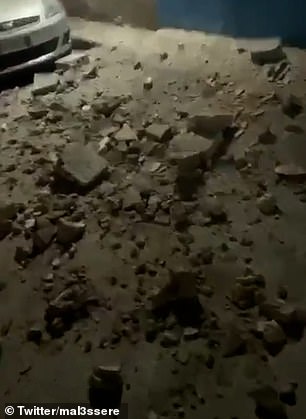
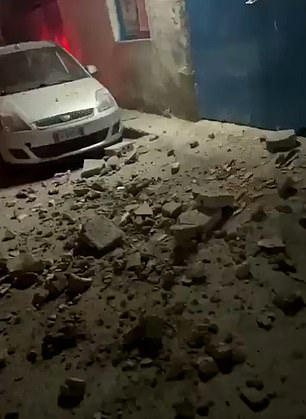
A magnitude 4.0 earthquake shook Italy’s volcanic Campi Flegrei region west of Naples yesterday as shocked residents posted videos of cars being pelted by debris during the worst of the tremors.
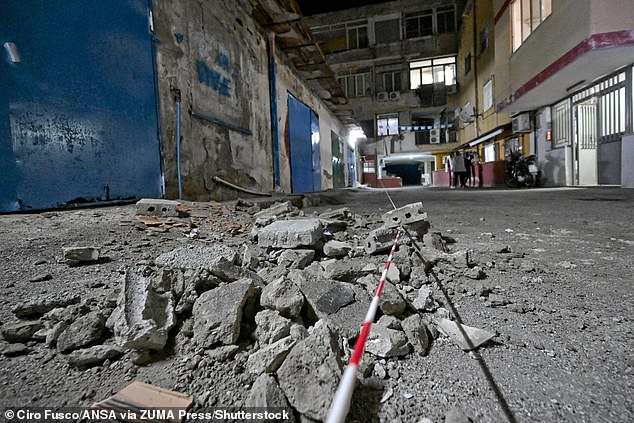
A 4.0 magnitude earthquake on the Campi Flegrei (Phlegrean Fields) has heightened concerns among people living in the volcanic area near Naples about a recent wave of seismic activity.
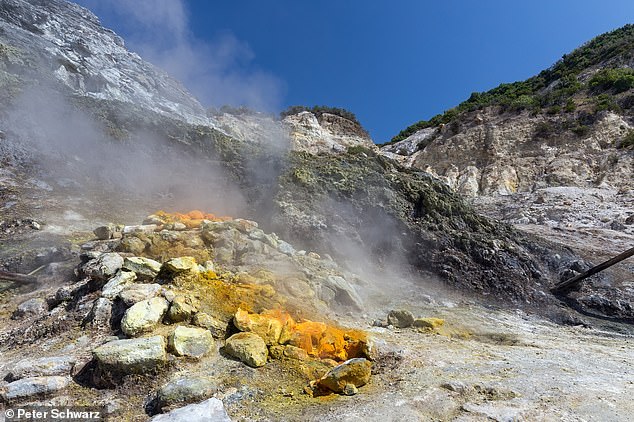
The Campi Flegrei volcano in southern Italy has become weaker and more prone to rupturing, making an eruption more likely, experts say. Pictured is Solfatara, a shallow volcanic crater that is part of Campi Flegrei
About 360,000 people live in the immediate vicinity of Campi Flegrei and may have to evacuate if experts believe there is an immediate danger of an eruption.
About three million people live in Naples, just fifteen kilometers away.
Scientists from Italy’s National Institute of Geophysics and Volcanology (INGV) planned meetings with local officials this week to draw up evacuation plans.
The supervolcano has been restless since the mid-20th century, which is of particular concern to scientists.
It experienced several two-year periods of unrest in the 1950s, 1970s and 1980s, resulting in small, local earthquakes and upward movement of the ground due to the movement of magma beneath the surface.
When the volcano eventually erupts, it will likely be comparable in size to the eruption of Mount Vesuvius that destroyed the cities of Pompeii and Herculaneum in 79 AD. destroyed.
Campi Flegrei is a collapsed supervolcanic caldera consisting of several craters and volcanic edifices.
A series of small-scale earthquakes and tremors have steadily weakened the caldera in recent decades, causing pressure to build beneath the surface.
The INGV says continued tremors will only increase pressure, creating the conditions required for an eventual eruption.
Professor Christopher Kilburn from UCL’s Department of Earth Sciences said Campi Flegrei is more susceptible to a ‘rift’ – a fracture or break in the rock that makes up the body of the volcano.
‘It is a natural consequence of the volcano being stretched as pressure builds underground,’ Professor Kilburn told MailOnline.
“Once a rupture has occurred, volcanic fluids can escape more easily.”
A rupture could open a crack in the Earth’s crust, although the magma must still push up in the right location before an eruption can occur.
Campi Flegrei is defined as a supervolcano because it has the potential to produce a magnitude 8 eruption, which could discharge more than 320 cubic kilometers of material.
The eruption last erupted when Henry VIII was last on the English throne, and this event occurred after an interval of about 3,000 years.
But the researchers warn that these types of large calderas often go through decades of turmoil before erupting.
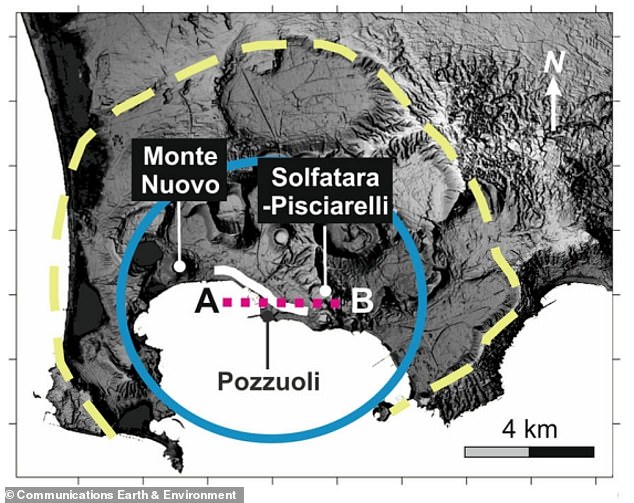
About 12 to 15 km wide, Campi Flegrei is the largest active caldera in Europe, stretching west from the outskirts of Naples to the Tyrrhenian Sea. About a third lies partly beneath the Bay of Pozzuoli; More than 360,000 people live in the remaining two-thirds. The caldera is marked by the yellow dotted line; Ground movement has occurred in the central area highlighted in blue

According to the London researchers, approximately 360,000 people live in Campi Flegrei (photo).
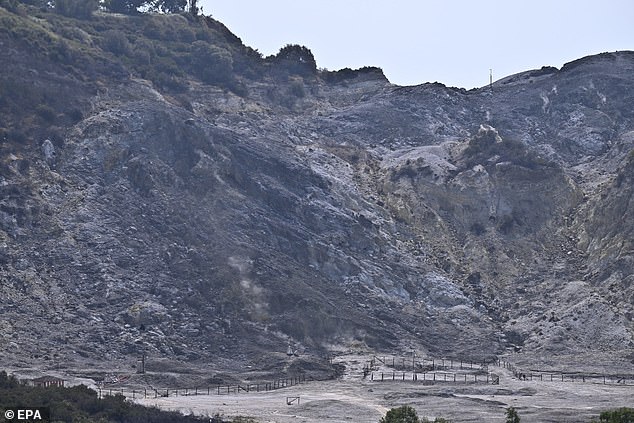
The closed Solfatara crater in Pozzuoli, Italy, September 27, 2023
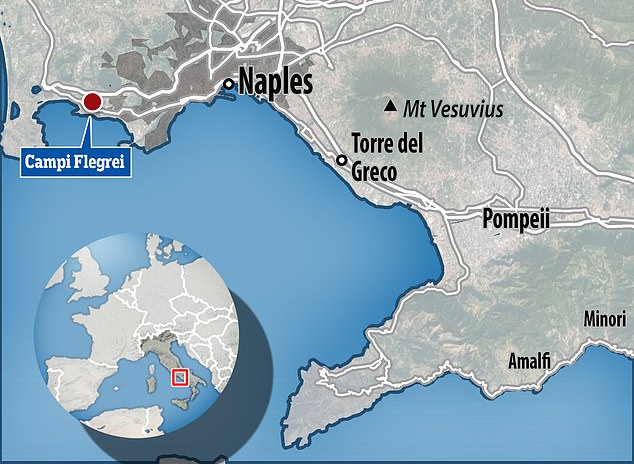
Naples is flanked on both sides by volcanoes: Campi Flegrei to the west and Vesuvius to the east
However, Campi Flegrei’s current tensile strength – the maximum stress a material can withstand before breaking when stretched – is likely to be about a third of what it was in 1984, the researchers said, due to regular vibrations.
In addition, the ground beneath Pozzuoli has been rising about four inches per year for the past decade as gas increases pressure in the magma, causing the ground surface to bulge and deform.
A recent study used a model of volcanic ruptures, developed at UCL, to interpret the patterns of earthquakes and ground uplift, and concluded that parts of the volcano had been stretched almost to the breaking point.
“This is the first time we have applied our model, which is based on the physics of how rocks fracture, to any volcano in real time,” says Professor Kilburn.
‘Our first use of the model was in 2017 and since then Campi Flegrei has been behaving as we predicted, with an increasing number of small earthquakes indicating pressure from below.
‘We will now have to adjust our procedures to assess the chances of new routes being opened for magma or gas to reach the surface.’
Worryingly, any eruption could be preceded by relatively weak signals, such as lower levels of ground uplift and fewer earthquakes.
This was the case with the 1994 eruption of the Rabaul caldera in Papua New Guinea, which killed only five people, largely due to good disaster planning.
The eruption was preceded by small earthquakes that occurred a tenth time faster than during a crisis ten years earlier.
Immediate signs that a volcano is about to erupt include cracks in the ground and dark streams of volcanic gases being emitted, although Campi Flegrei is not yet at this stage.

